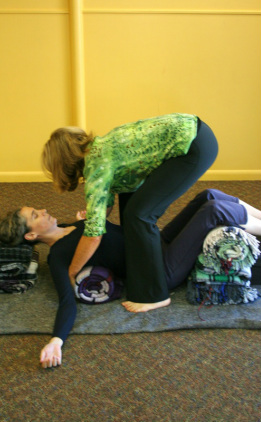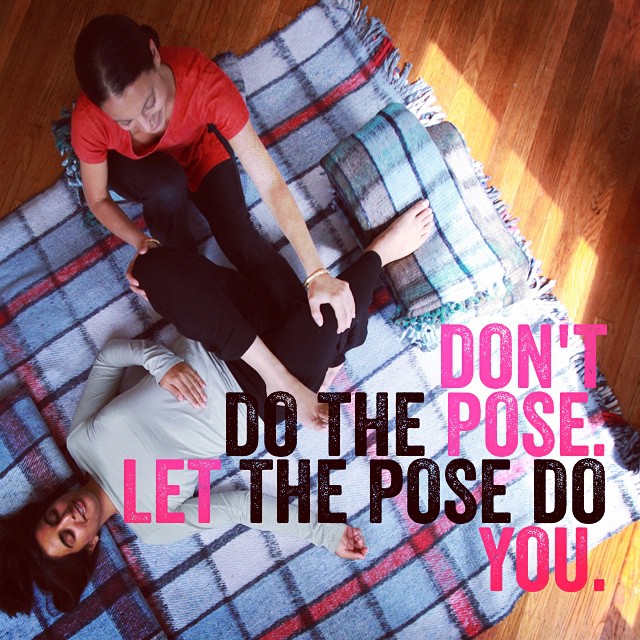Deep Spinal Release Bodywork and Instruction:
The approach for both of the modalities that I do with clients = Collaboration and Healing Facilitation
Both approaches are also about your relationship with your own being, the most important relationship you'll ever have. We are exploring embodiment practices to find what resonates with you, so that doing practices on your own becomes effortless.
You know if you have spinal tension, and there are many approaches that you can choose to get relief. The core of the technology I use is one is based upon what I learned from Master Yoga Academy in La Jolla (no longer exists) that was developed by a massage therapist/Yoga teacher/mom and now a Swami formerly known as Rama Berch. She was the first president of the Yoga Alliance. She is not, what my teacher Kaya Mindlin calls a “Yogalebrity” …most of the teachers I’ve studied with aren’t “celebrities” - however, I can say without a doubt that many of them are genius level teachers that have developed their own way of working with our body in ways that are VERY effective for not only chronic pain but for Self Realization via the knowing of YOU through sacred imminence = embodiment - The Feminine Divine, or what I personally call HER
For new clients this is what I recommend:
- 1 Intake session - 45 minutes to an hour ($108 or free with sessions)
- 4 Deep Spinal Release Bodywork Sessions ($432)
- 4 Deep Spinal Release Instructional Sessions ($432)
For those who want to go deeper I recommend 4x4x4
- 4 sessions of Bodywork only (I do you)– no instructions, just receiving this very different way of working with your body and letting it marinate. So your body knows….we allow for it to know how this feels after repeating the experience 4 times, 4 weeks in a row if possible.
- 4 sessions of Instruction –( you do you) after doing the initial 4 sessions of Bodywork, I’ll check in and see if you want to learn how to do this bodywork on yourself. We will come up with a Home Practice that suites you over the 4 weeks.
- 4 more Bodywork sessions – (you are doing you and I am doing you)now you have a kickstart 4 x 4 and if you want to go deeper, you do your home practice and do 4 more Bodywork sessions.
- After that you may want to come in less frequently, once a month or every two weeks. Some people come for weekly sessions instead of doing massage or cranial sacral. This is their main Bodywork modality. Their body just craves it
- Conduit of consciousness
- Kundalini
- Dormant tendencies
- Your nervous system
- Your mind
- Your body, your joints
Key principals
- Samanya (Universal) Dharma is primary (nonharming)-doing what is right, over what is liked and simultaneously being loving and kind
- Awareness of the body
- Poses angle into and release core (spinal) tension/blockages
- Cultivate a parasympathetic (calming, or finding safety physiology) nervous system response
- When the body slows down, the mind slows down
- Support a process of surrender (letting go) as a means to Self Awareness
- Props provide support and alignment
- Release, not stretch
- Get tight (core) areas moving
- Stabilize the joints/prevent overstretching
- Repetition = calms the mind
- Inward oriented and non -competitive
- Teacher teaches, does not do a performance of yoga for the group
- Teacher looks at individual bodies and does hands on alignments
- Precise, personalized alignment and props
- Settling the mind as the main means for healing, transformation and awareness (parasympathetic)
- Cultivating meditation
- Letting go (physical tension, mental resistance, pain, preferences)
- Sequencing that considers the effect of the pose architecture on the body/mind
- Teaching according to themes (if teaching classes)
- Preparing, Moving in, being in, moving out, being still and noticing the effects are equally important
*Excerpt from Kaya Mindlin SRY
Deep Spinal Release Bodywork
Yoga Therapy is a tailored one-on-one profession, which has similarities to other modalities in that there is an intake process and evaluation. Followed up by recommendations and a treatment plan or choice of plans to work with the practitioner.
There are literally hundreds of different styles or approaches to Yoga and Yoga Therapy, so just like when you go in for an acupuncture treatment, or a chiropractic appointment, you will find there are a myriad of methods even within the same profession. Generally it is suggested that you work with a Yoga Therapist for a series of sessions in order to see results. The idea is to jump start your healing facilitation ( Tier 1) and then to give you tools so that you do not rely on the practitioner (Tier 2). Any good healing facilitator empowers the individual to find what works for them, assisting and supporting as long as needed, but then eventually less and less. For some, doing both a home practice and having a set of scheduled ‘deeper’ sessions with a Therapist is the best choice. For others, it’s a matter of doing a series or a few series of sessions then developing a home practice that works within their schedules and needs."
This is my approach to Yoga Therapy
Tier 1. We do a series of one-on-one sessions that are akin to bodywork/massage/acupuncture, which is unique to the Yoga Therapy training I've received. In a session there is very little instruction, rather it is a modality where you are able to be quiet and still, diving in to a deep state of relaxation stimulating the parasympathetic nervous system.
There is nothing to "learn" or "Remember". You are just getting a very deep experience, which generally entails a few very well propped poses, including some gentle hands on.
Tier 2. I teach you easy practices that you can do at home. You would have a plan tailored to your body type, your issues, your lifestyle and to whatever will assist in supporting your Home Practice. There may be some other recommendations that are in alignment with the principals of Ayurveda.
When is Yoga Therapy covered under insurance?
While I don't get reimbursed by insurance companies (at least not yet) I have been able to work with individuals who have gotten a referral from a doctor or a chiropractor. If you have an HSA or FSA and you get a referral you would be able to use funds to cover Yoga Therapy. If you are recovering from a workers comp injury or have been involved in an accident and have a Personal Injury claim, you may be able to incorporate Yoga Therapy as part of your recovery plan.
Yoga Therapy is a tailored one-on-one profession, which has similarities to other modalities in that there is an intake process and evaluation. Followed up by recommendations and a treatment plan or choice of plans to work with the practitioner.
There are literally hundreds of different styles or approaches to Yoga and Yoga Therapy, so just like when you go in for an acupuncture treatment, or a chiropractic appointment, you will find there are a myriad of methods even within the same profession. Generally it is suggested that you work with a Yoga Therapist for a series of sessions in order to see results. The idea is to jump start your healing facilitation ( Tier 1) and then to give you tools so that you do not rely on the practitioner (Tier 2). Any good healing facilitator empowers the individual to find what works for them, assisting and supporting as long as needed, but then eventually less and less. For some, doing both a home practice and having a set of scheduled ‘deeper’ sessions with a Therapist is the best choice. For others, it’s a matter of doing a series or a few series of sessions then developing a home practice that works within their schedules and needs."
This is my approach to Yoga Therapy
Tier 1. We do a series of one-on-one sessions that are akin to bodywork/massage/acupuncture, which is unique to the Yoga Therapy training I've received. In a session there is very little instruction, rather it is a modality where you are able to be quiet and still, diving in to a deep state of relaxation stimulating the parasympathetic nervous system.
There is nothing to "learn" or "Remember". You are just getting a very deep experience, which generally entails a few very well propped poses, including some gentle hands on.
Tier 2. I teach you easy practices that you can do at home. You would have a plan tailored to your body type, your issues, your lifestyle and to whatever will assist in supporting your Home Practice. There may be some other recommendations that are in alignment with the principals of Ayurveda.
When is Yoga Therapy covered under insurance?
While I don't get reimbursed by insurance companies (at least not yet) I have been able to work with individuals who have gotten a referral from a doctor or a chiropractor. If you have an HSA or FSA and you get a referral you would be able to use funds to cover Yoga Therapy. If you are recovering from a workers comp injury or have been involved in an accident and have a Personal Injury claim, you may be able to incorporate Yoga Therapy as part of your recovery plan.


